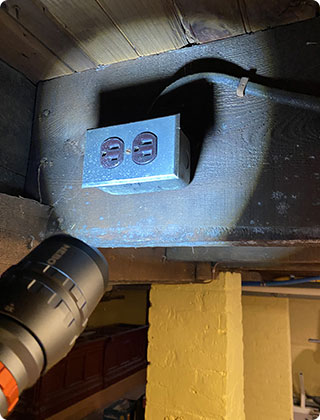MENU


Mold in crawl areas is a problem that many homeowners and people who are buying homes run into. This complete guide will explain in detail how to find mold in crawl spaces, including the right way to do it, what moldy things to look for and what risks might be present in your crawl space if you have mold.
Mold in crawl spaces is often hard to find because it hides in places that aren't obvious. To spot possible mold growth, there are a few main signs that should make you worry. Some of these are a musty smell, mold growth that can be seen, water spots on surfaces or materials, building materials breaking down, and a lot of allergic reactions.
It is important to check your crawl area carefully for any mold problems, as some signs may be more noticeable than others. If you don't treat mold, it can damage your home and put your health at risk, so don't ignore the warning signs. It's important to act right away if you think mold is growing in your crawl area.
It's very important for homeowners to know what can happen if mold grows in their crawl areas. The health risks that mold might cause are one of the biggest worries, especially for people with asthma, allergies, or weak immune systems.
Aside from being harmful to health, mold can damage a building's structure over time, which can be very expensive to fix. A mold problem can also lower the market value of a home, making it less appealing to people who want to buy it.
In some cases, homes could even get in trouble with the law if they don't fix mold problems that put people's health at risk. Because of this, you need to act quickly if you think mold is spreading in your crawl space.
The effects can get worse and cost more the longer you wait to deal with the problem. The most important thing for keeping a safe and healthy setting for both homeowners and residents is to get professional help to get rid of the mold's source.
It is very important to follow a set of steps when looking for mold. Crawl spaces are often damp, dark, and hard to get to, which makes them great for mold growth. How we find mold in crawl places is as follows:
Today's problems need today's answers. Utilizing advanced tools is necessary for a full evaluation when it comes to mold identification. Infrared cameras can find changes in temperature, which can show problems with moisture that can lead to mold growth. Air quality monitors find out how many mold spores are in the air, which is useful information for tests for mold. Moisture meters correctly measure how much water is in building materials, which helps find places where mold is likely to grow.
There are do-it-yourself options, like home testing kits, but professional mold testing services are the most accurate and knowledgeable. Mold is a dangerous enemy that often hides in places you wouldn't expect. Professionals not only have access to high-tech tools, but they also know how to interpret the data correctly.
Think about this question: how much mold is okay in a crawl space? Professionals can give you advice based on industry standards, which will give you a full picture of the mold amounts in your home.
Remember that taking care of your home's health is an investment, and if you try to save money by doing things yourself, you might miss problems. Put your mold discovery in the hands of professionals who can give you a full report and useful advice.
To sum up, mold in crawl areas is a serious issue that needs to be dealt with right away. To keep your home safe and your family healthy, you need to find mold early and have a professional test it.
It's time to do something about mold in crawl spaces now that you know more about it. Get in touch with O2 Mold Testing right away if you need professional mold testing services. Our skilled professionals can help you figure out what's going on, offer answers, and make sure you and your family live in a healthy place.
We're here to help you keep your home mold-free because it's where you feel safest. Get in touch with us right away to get peace of mind and a healthy place to live. It's worth it for the health of your family!